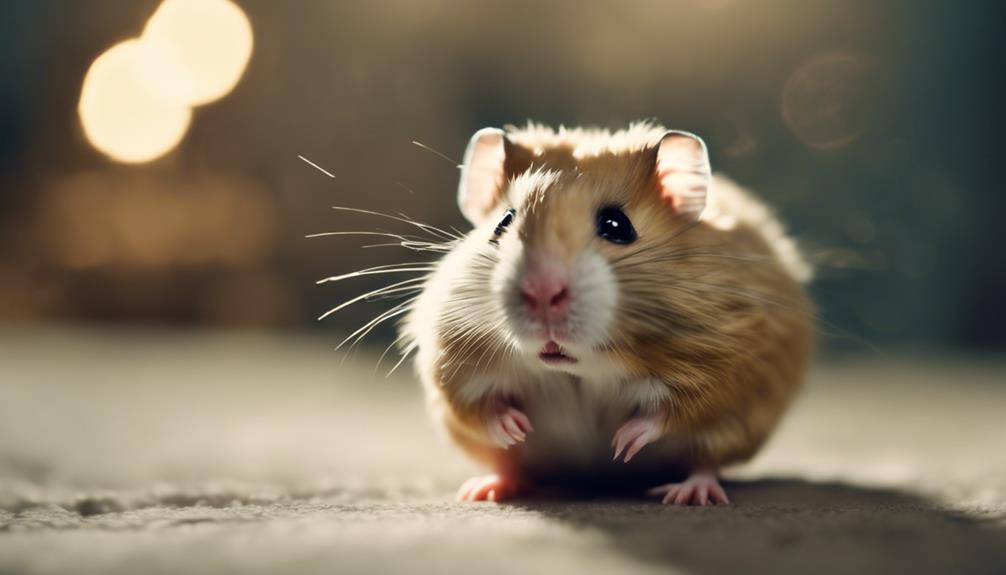What Are the Signs of Stress in Hamsters?

Signs of stress in hamsters include changes in appetite, grooming habits, and sociability.
Observing their body language and listening to their vocalizations can also provide insights into their well-being.
Understanding these cues can help decipher a stressed hamster's silent language of distress.
Changes in Eating Habits
When observing hamsters for signs of stress, one should pay close attention to any changes in their eating habits. These small creatures often show their distress through alterations in their appetite and consumption patterns. Weight loss and dehydration are common indicators that something may be amiss in a hamster's world. If one notices their furry friend eating significantly less or showing signs of dehydration, it could be a red flag signaling stress.
Moreover, digestive issues and malnutrition can also be linked to stress in hamsters. Stress can impact their digestive system, leading to irregular bowel movements or a lack of interest in food, which may result in malnutrition over time. It's crucial to monitor their eating habits regularly to ensure they're maintaining a healthy diet.
Excessive Grooming
Excessive grooming in hamsters may manifest as hair loss from over-grooming, skin irritation, or even wounds caused by excessive cleaning. This behavior can indicate stress or discomfort in the hamster's environment.
Observing any obsessive grooming habits in your hamster should prompt a closer look at potential stressors to ensure their well-being.
Hair Loss From Grooming
In some cases, hamsters may experience hair loss due to excessive grooming. This behavior often stems from stress and can be a sign of underlying issues that need attention.
Here are a few key points to consider:
- Monitor Behavior: Pay attention to your hamster's grooming habits. Excessive grooming, leading to hair loss, could indicate heightened stress levels.
- Provide Enrichment: Ensure your hamster has a stimulating environment with toys and activities to reduce stress and prevent excessive grooming.
- Consult a Vet: If you notice significant hair loss or changes in grooming behavior, seeking advice from a veterinarian specializing in small animals can help address any potential health concerns promptly.
Skin Irritation or Wounds
To understand the impact of excessive grooming on hamsters, it is essential to recognize the potential for skin irritation or wounds that may arise from this behavior. Excessive grooming can lead to dry skin, causing hamsters to scratch excessively, resulting in matted fur and redness. Hamsters, in their meticulous grooming routine, may inadvertently harm themselves, leading to skin abrasions or wounds. It is crucial for hamster owners to observe their pets for any signs of skin irritation or wounds caused by over-grooming. Providing a safe environment, suitable bedding, and engaging toys can help alleviate stress that may trigger excessive grooming habits in hamsters.
| Signs of Skin Irritation or Wounds |
|---|
| 1. Dry skin, scratching |
| 2. Matted fur, redness |
Obsessive Cleaning Behavior
Hamsters meticulously attending to their grooming needs can sometimes display behavior that goes beyond mere cleanliness, potentially indicating a deeper issue related to their well-being. Excessive grooming, often seen as obsessive cleaning behavior, might signal stress in hamsters. This behavior could be a way for them to cope with anxiety or discomfort, leading to potential health problems if not addressed promptly.
To recognize if your hamster is exhibiting this behavior, consider the following:
- Nesting behavior: Excessive grooming may lead to obsessive nesting, where the hamster spends an unusual amount of time building or rearranging its nest.
- Behavioral changes: Watch out for any sudden shifts in your hamster's behavior, such as increased irritability or decreased appetite.
- Cage cleanliness: Ensure the cage is clean and comfortable, as a dirty environment can contribute to stress indicators in hamsters.
Aggression or Irritability
When observing hamsters, one may notice signs of aggression or irritability as indications of underlying stress. Hamsters, like any other living being, can display aggression when feeling threatened or stressed. This aggression may manifest through biting, scratching, or vocalizing more than usual. On the other hand, irritability in hamsters can be seen when they become easily agitated, restless, or seem on edge. Understanding these signs can help hamster owners address the root cause of stress before it escalates.
| Signs of Aggression or Irritability |
|---|
| 1. Biting |
| 2. Scratching |
| 3. Increased vocalization |
To alleviate these behaviors, owners can implement training techniques and behavioral modifications. By creating a safe and comfortable environment for the hamster, providing enriching activities, and ensuring regular and gentle interactions, owners can help reduce their pet's stress levels. Remember, a calm and peaceful environment goes a long way in fostering a happy and stress-free hamster.
Hiding or Seeking Solitude

Seeking solitude, hamsters retreat to quiet corners or cozy hideaways when feeling overwhelmed by stressors in their environment. This behavior is a natural coping mechanism for them to find peace and regain a sense of security.
During times of stress, hamsters may exhibit the following behaviors:
- Reduced Social Interaction: Stressed hamsters tend to withdraw from social interactions with their cage mates or human caregivers. They prefer solitude over company to alleviate their anxiety.
- Increased Time Spent in Hideouts: Hamsters under stress may spend more time in their hideouts or burrows, seeking comfort and safety in these familiar spaces.
- Importance of Environmental Enrichment: Providing a well-enriched environment with tunnels, nesting materials, and chew toys can offer hamsters the mental stimulation they need to prevent stress and encourage healthy behaviors.
Understanding and respecting a hamster's need for solitude is crucial in creating a harmonious and stress-free environment for these small, sensitive creatures.
Increased Vocalization
In times of heightened stress, hamsters may communicate their unease through an increase in vocalization, expressing their inner turmoil through sounds that convey their emotional state. The vocalization frequency and behavior of a hamster can serve as a window into their world, revealing signs of distress that shouldn't be ignored. These tiny creatures, often silent and discreet, may suddenly find solace in making their voices heard when facing overwhelming situations.
The causes of increased vocalization in hamsters can vary, ranging from environmental stressors to health issues. Understanding the root of this behavior is crucial in addressing their needs effectively. Providing a safe and stimulating environment, ensuring proper nutrition and hydration, and offering gentle interactions can all contribute to reducing their stress levels and minimizing excessive vocalization.
When a hamster's voice becomes louder than usual, it's their way of seeking attention and expressing discomfort. By listening attentively and responding with care, one can help alleviate their anxiety and create a harmonious space where these small beings can thrive peacefully.
Restlessness or Inactivity

Hamsters, like all creatures, may exhibit signs of stress through restlessness or inactivity.
Excessive grooming behavior or sudden changes in appetite are common indicators of underlying stress in these small pets.
Excessive Grooming Behavior
Excessive grooming behavior in hamsters may manifest as a repetitive and obsessive self-care routine, indicating potential stress or discomfort. When observing your furry friend, consider the following behavioral cues as indicators of stress:
- Increased Grooming Frequency: If you notice your hamster grooming excessively, constantly licking or biting themselves, it could be a sign of stress.
- Hair Loss or Skin Irritation: Over-grooming can lead to hair loss or skin irritation, which are physical manifestations of the stress your hamster may be experiencing.
- Agitation or Restlessness: A stressed hamster may exhibit increased agitation or restlessness, often pacing or displaying erratic behavior.
Changes in Appetite
Changes in appetite can serve as a subtle yet telling indicator of your hamster's well-being, reflecting either restlessness or inactivity within their daily routine. Monitoring your hamster's food preferences, weight loss, digestive issues, and hydration levels can provide valuable insights into their overall health. Here is a table to help you track and understand your hamster's changing appetite:
| Indicator | Meaning |
|---|---|
| Weight loss | Possible sign of stress or illness |
| Food preferences | Changes can indicate stress levels |
| Digestive issues | Upset stomach due to stress |
| Hydration levels | Dehydration can affect appetite |
| Eating patterns | Sudden changes may signal stress |
Physical Symptoms
Amidst the delicate nature of hamsters, their bodies may subtly reveal signs of stress through various physical manifestations. When observing your furry friend for stress indicators, keep an eye out for the following physical manifestations:
- Fur Loss: Excessive grooming or rubbing due to stress can lead to patches of fur loss in hamsters. If you notice bald spots on your hamster, it could be a sign of underlying stress that needs to be addressed promptly.
- Weight Loss or Gain: Changes in weight can be a significant physical indicator of stress in hamsters. A sudden loss or gain of weight without any apparent cause could point towards stress affecting your pet's well-being.
- Agitation and Restlessness: Hamsters under stress may display increased agitation and restlessness. They might exhibit pacing behavior, excessive scratching, or even startle easily at minor disturbances. These physical signs can be telling of their inner turmoil and shouldn't be overlooked.
Being attuned to these physical manifestations can help you identify and alleviate stress in your hamster, promoting their overall health and happiness.
Changes in Body Language

Observing the subtle shifts in a hamster's body language can provide valuable insights into their emotional state. Behavioral changes and stress indicators are often communicated through these non-verbal cues. When a hamster is stressed, they may exhibit various stress signals through their body language. One common sign is excessive grooming or self-barbering, which can indicate anxiety or discomfort. If a hamster starts to display repetitive behaviors like pacing or circling, it could be a sign of distress. Additionally, changes in posture such as hunching or freezing in place might suggest that the hamster is feeling threatened or overwhelmed.
Communication cues in a hamster's body language are essential for understanding their well-being. By paying attention to these subtle signs, one can better support their furry friend during times of stress. Remember, each hamster is unique, so it's crucial to observe their individual behaviors and responses to identify any potential stressors. By fostering a safe and comfortable environment, you can help alleviate their worries and promote a harmonious bond.
Frequently Asked Questions
Can Stress in Hamsters Be Contagious to Other Hamsters in the Same Environment?
Stress transmission in hamsters can affect group dynamics. Behavioral changes due to stress can influence social interactions. While stress itself isn't contagious like a virus, its impact on behavior can indirectly influence other hamsters in the same environment.
How Can I Help My Hamster Cope With Stress if I Notice Any of These Signs?
To help a stressed hamster cope, offer enrichment activities and try behavior modification. Use bonding techniques and gentle handling tips. Create a peaceful environment and show patience. Remember, understanding and love go a long way in supporting a hamster's well-being.
Are There Any Specific Environmental Factors That Can Trigger Stress in Hamsters?
In a hamster's world, the right cage setup and temperature regulation are key. Social interaction and enrichment activities play vital roles in their well-being. When these elements align, stress fades, and hamsters thrive in their cozy abode.
Can Stress in Hamsters Lead to Long-Term Health Issues?
Stress management is crucial for hamsters as chronic stress can lead to long-term health issues. By providing a calm environment, proper diet, and regular exercise, hamster owners can help mitigate the potential health implications of stress on their furry companions.
Is There a Way to Prevent Stress in Hamsters Before It Becomes a Problem?
In the realm of hamster care, early intervention is key to preventing stress. Training and introducing enrichment activities can help mitigate potential behavioral changes. By nurturing their environment, one can create a haven of calm for these small creatures.









